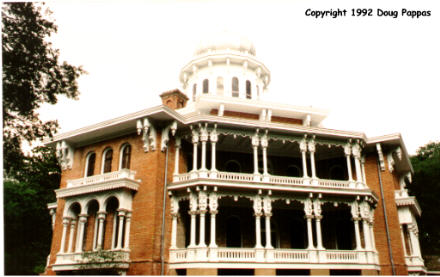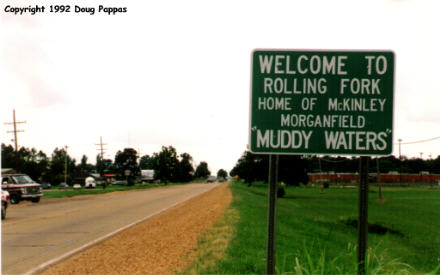Tuesday, August 11, 1992...
Began the day by driving around historic Natchez for two hours, passing more than half the 40 historic residences now open for tours. The only one I actually visited was Longwood, a three-story octagonal house, crowned by a massive dome, which was left unfinished when the Civil War deprived the builder of his work force. Longwood's managers had the foresight (and the land) to put the fee-collection station so far down the winding path that the house isn't visible until you've paid. This probably accounts for a good number of the claimed 100,000 annual visitors Longwood receives...

Then I turned north toward Memphis. At Port Gibson I'd hoped to turn west for the ruins of Windsor, the state's grandest mansion, which burned in 1890, but no signs marked the road and the likeliest candidate had a Bridge Out sign. At Vicksburg, I drove around the National Military Park; the drive took longer than I'd planned, in large part because of a cretin who insisted on driving 15 MPH when not slowing down to a crawl to read all the pretty signs along the roadside.
The park encircles the city of Vicksburg, site of one of the Civil War's deadliest sieges. Seeking control of the Mississippi River, Union troops under General Ulysses S. Grant surrounded the city for 47 days, sustaining 17,000 fatalities, before the city finally surrendered. Vicksburg fell to the North on July 4, 1863 -- mere hours after Robert E. Lee's retreat from Gettysburg. Although the war dragged on for 21 months, the South's fate was sealed. The battlefield contains over 1,300 monuments, as well as the restored U.S.S. Cairo, torpedoed by the Confederates in 1862 and raised over a century later. The ship and hundreds of its artifacts are displayed in the northwest corner of the park.
Then continued north toward Memphis, through the fabled Mississippi Delta. The drive wasn't as picturesque as I'd hoped, at least partly because I was driving the main through road. From Vicksburg north to Leland, the drive passed through nothing but cotton fields, but for the 40 miles on either side of Clarksdale the ramshackle houses and closed businesses I'd been expecting were much more apparent.
Mississippi natives dominated American music for fifty years. Both Jimmie Rodgers, the Father of Country Music, and Elvis Presley, the King of Rock 'n' Roll, were born here, but Mississippi's greatest musical legacy is the blues. Charley Patton, Robert Johnson, Muddy Waters, Howlin' Wolf, Jimmy Reed, John Lee Hooker, B.B. King, Otis Rush and many others learned their craft in the towns and plantations of Mississippi.

The Delta Blues Museum occupies the top floor of Clarksdale's Carnegie Public Library [it has since moved], just blocks from the junction of Routes 49 and 61, Robert Johnson's legendary "Crossroads." The Museum honors Mississippi's blues history with photos and exhibits -- and since it's in a library, with an immense amount of blues and Mississippi-related reading matter. I only wish it had an equivalent-sized listening room.
I returned to 61 and continued north through Memphis, following the route taken by so many of these musicians. 61 sneaks into Memphis from the south, spending fewer than a dozen nondescript miles in the state and passing nothing of interest. 61 turns west on Crump Avenue, magically joining I-55 for the swing across the Mississippi south and west of downtown Memphis. It stays with I-55 for 23 miles in Arkansas; the turnoff's not marked at all, though, and I had to reverse course on the Interstate to avoid a 12-mile detour/backup. Spent the night in Blytheville, Arkansas, just south of the Missouri line.
Go to the next day
Back to Old Road Trips menu
Back to ROADSIDEPHOTOS.COM home page